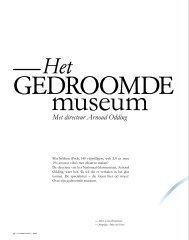Dichter op de Huid - O dubbel d
Dichter op de Huid - O dubbel d
Dichter op de Huid - O dubbel d
You also want an ePaper? Increase the reach of your titles
YUMPU automatically turns print PDFs into web optimized ePapers that Google loves.
PREFACE<br />
Connecting the fragments<br />
Almost everything we see, we are used to seeing from the outsi<strong>de</strong>,<br />
be it a chair, a computer or a person. On the rare occasion that we<br />
do glimpse below the surface, it is surprising, confusing or shocking.<br />
Skin is perfectly normal and extraordinary at the same time, full of<br />
contradictions.<br />
Anyone wishing to research skin will find several exhibitions on<br />
Internet in which a different aspect of skin is highlighted each<br />
time: skin and fashion, architecture and skin, skin and i<strong>de</strong>ntity, the<br />
physics of skin, <strong>de</strong>sign and skin; and yes even glass skin. Everybody<br />
views skin from their own perspective: the architect sees the larger<br />
form, the philos<strong>op</strong>her the world’s mask, the poet a metaphor and<br />
the tra<strong>de</strong>r a market. Skin confronts us with our fragmented views<br />
of the world. The exhibition <strong>Dichter</strong> <strong>op</strong> <strong>de</strong> <strong>Huid</strong> (Skin Deep) and this<br />
publication place some of these fragments next to each other, like<br />
pieces of a puzzle, colour by colour, the outsi<strong>de</strong> facing up, looking<br />
carefully to see what fits. <strong>Dichter</strong> <strong>op</strong> <strong>de</strong> <strong>Huid</strong> is merely scratching at<br />
the surface of a colossal project, a careful attempt at mapping the<br />
many ways we give meaning to the skin around us. The words, the<br />
formulas and the art that in turn create an image, ungraspable,<br />
ephemeral, inexpressible in words. This exhibition aims to overcome<br />
the fragmented meanings in our mind: unavailingly yet beautifully.<br />
VOORWOORD<br />
De samenhang <strong>de</strong>r splinters<br />
Van vrijwel alles dat we zien zijn we gewend aan <strong>de</strong> buitenkant, of<br />
het nu een stoel, een computer of een mens is. De enkele keer dat<br />
we <strong>de</strong> binnenkant te zien krijgen is dat verrassend, verwarrend of<br />
shockerend. De huid is doodgewoon en bijzon<strong>de</strong>r tegelijk, een vel<br />
vol tegenstrijdighe<strong>de</strong>n. Wie zich een beetje verdiept in <strong>de</strong> huid<br />
komt <strong>op</strong> internet meer<strong>de</strong>re tentoonstellingen tegen waar telkens<br />
een an<strong>de</strong>r aspect van <strong>de</strong> huid getoond werd: <strong>de</strong> huid in <strong>de</strong> mo<strong>de</strong>;<br />
architectuur en huid; huid en i<strong>de</strong>ntiteit, <strong>de</strong> fysica van <strong>de</strong> huid;<br />
<strong>de</strong>sign en huid; ja zelfs <strong>de</strong> huid van glas. Ie<strong>de</strong>r kijkt vanuit zijn<br />
eigen perspectief naar <strong>de</strong> huid. De architect ziet <strong>de</strong> grote vorm,<br />
<strong>de</strong> filosoof het masker van <strong>de</strong> wereld, <strong>de</strong> dichter een metafoor en<br />
<strong>de</strong> on<strong>de</strong>rnemer een markt. De huid confronteert ons met onze<br />
versplinter<strong>de</strong> wereldbeel<strong>de</strong>n. De tentoonstelling <strong>Dichter</strong> <strong>op</strong> <strong>de</strong> <strong>Huid</strong> en<br />
<strong>de</strong>ze publicatie leggen een aantal van die splinters naast elkaar, als<br />
puzzelstukjes. Kleur bij kleur, <strong>de</strong> buitenkant naar boven, voorzichtig<br />
kijken wat er past. <strong>Dichter</strong> <strong>op</strong> <strong>de</strong> <strong>Huid</strong> is niet meer dan ruiken aan een<br />
titanenproject, een aarzelen<strong>de</strong> poging tot cartograferen van <strong>de</strong> vele<br />
manieren waar<strong>op</strong> wij betekenis geven aan <strong>de</strong> huid om ons heen. De<br />
woor<strong>de</strong>n, <strong>de</strong> formules en <strong>de</strong> kunst die er eigen ongrijpbare, meestal<br />
niet in taal te vangen, verbeeldingen aan geven. Deze tentoonstelling<br />
wil <strong>de</strong> versplinter<strong>de</strong> betekenissen in ons hoofd doorbreken.<br />
Vergeefs, maar in schoonheid.<br />
PREFACE<br />
Voorwoord<br />
Juni 2008<br />
Tiziana Nespoli and Arnoud Odding<br />
Tiziana Nespoli en Arnoud Odding<br />
The curators of <strong>Dichter</strong> <strong>op</strong> <strong>de</strong> <strong>Huid</strong> (Skin Deep) are Arnoud Odding and Tiziana Nespoli. Tiziana Nespoli is a<br />
freelance exhibition producer in Amsterdam and has been Head of Exhibitions for The Zoological Museum<br />
Amsterdam of the University of Amsterdam since 1997. Arnoud Odding foun<strong>de</strong>d the production bureau O<br />
<strong>dubbel</strong> d in The Hague in 1990 and is Director of Stichting Glas: the museum umbrella organisation of the<br />
National Glass Museum and the Glasblazerij Leerdam.<br />
In 2004 they published the book Het Gedroom<strong>de</strong> Museum (The Dreamed Museum), a series of essays in<br />
which they <strong>de</strong>scribe the origins of museums as places where cultural and scientific insights were generated,<br />
presented and <strong>op</strong>enly discussed. In this publication they attempted to re-<strong>de</strong>fine a museum as a think tank<br />
for scientists, artists, philos<strong>op</strong>hers and of course the general public; a place where everybody was able to<br />
play a dubious role. Since then, they have jointly published various articles in which this method of doubt<br />
was tested on diverse subjects.<br />
De curatoren van <strong>Dichter</strong> <strong>op</strong> <strong>de</strong> <strong>Huid</strong> zijn Arnoud Odding en Tiziana Nespoli. Tiziana Nespoli is zelfstandig<br />
tentoonstellingsmaker te Amsterdam en sinds 1997 Hoofd Tentoonstellingen van het Zoölogisch Museum<br />
van <strong>de</strong> Universiteit van Amsterdam. Arnoud Odding begon in 1990 het organisatiebureau O <strong>dubbel</strong> d te Den<br />
Haag en is tevens directeur van <strong>de</strong> Stichting Glas: <strong>de</strong> museale koepel van het Nationaal Glasmuseum en <strong>de</strong><br />
Glasblazerij Leerdam.<br />
In 2004 publiceer<strong>de</strong>n zij het boek Het Gedroom<strong>de</strong> Museum, een serie essays waarin zij <strong>de</strong> oorsprong<br />
van musea beschrijven als plaatsen waar culturele en wetenschappelijke inzichten wer<strong>de</strong>n gegenereerd,<br />
gepresenteerd en publiekelijk ter discussie gesteld. Zij probeer<strong>de</strong>n in <strong>de</strong>ze publicatie het museum te<br />
her<strong>de</strong>finiëren als een ‘<strong>de</strong>nktank voor wetenschappers, kunstenaars, filosofen en natuurlijk het algemeen<br />
publiek; een plek waar ie<strong>de</strong>reen een twijfelachtige rol kan spelen.’ Sinds 2004 publiceer<strong>de</strong>n zij samen diverse<br />
artikelen waarin <strong>de</strong>ze metho<strong>de</strong> van <strong>de</strong> twijfel <strong>op</strong> uiteenl<strong>op</strong>en<strong>de</strong> on<strong>de</strong>rwerpen werd uitgetest.<br />
2 Nationaal Glasmuseum Leerdam / Fort Asperen Skin Deep / <strong>Dichter</strong> <strong>op</strong> <strong>de</strong> huid 3



